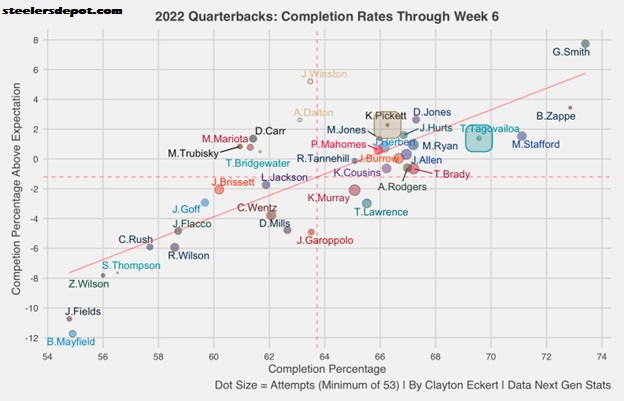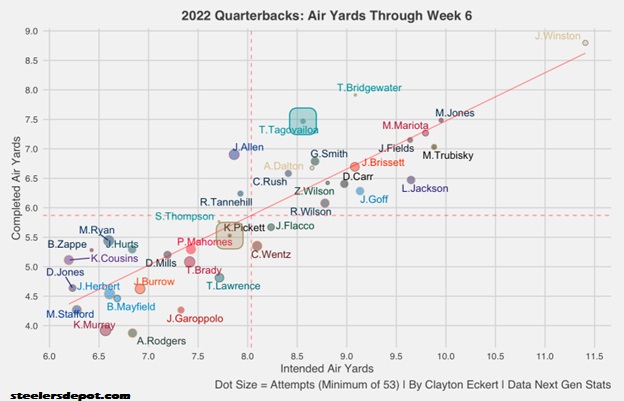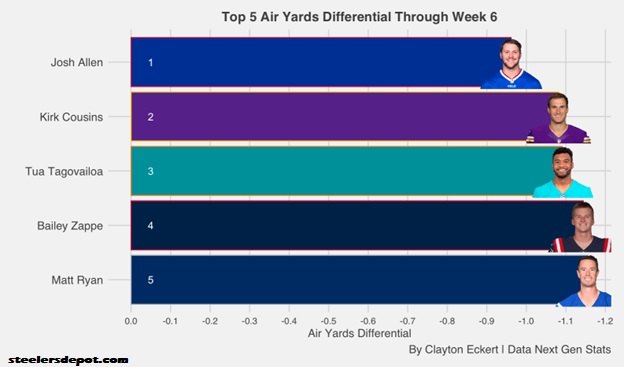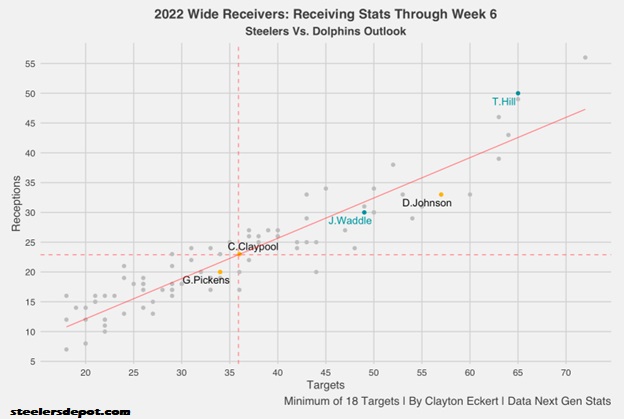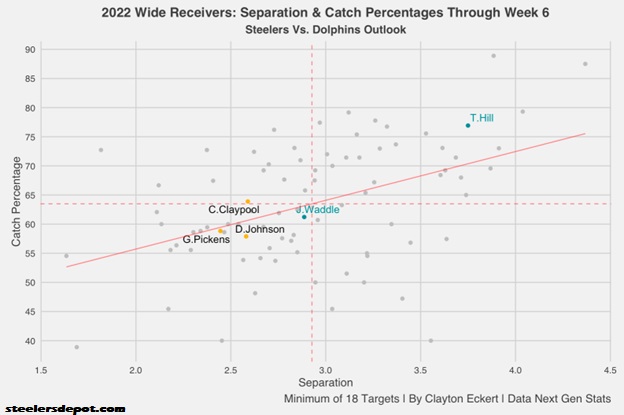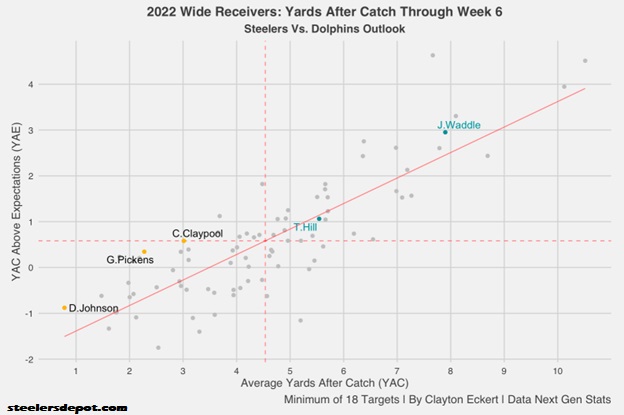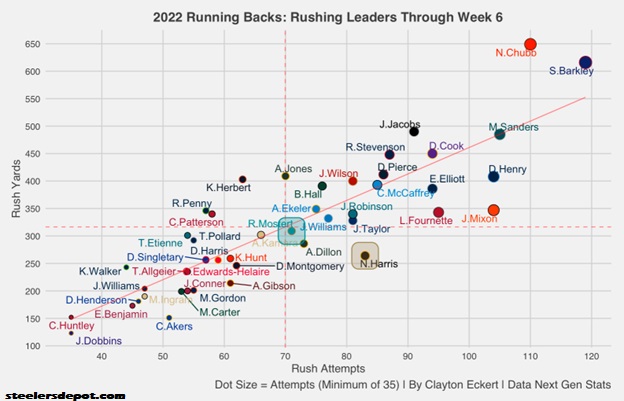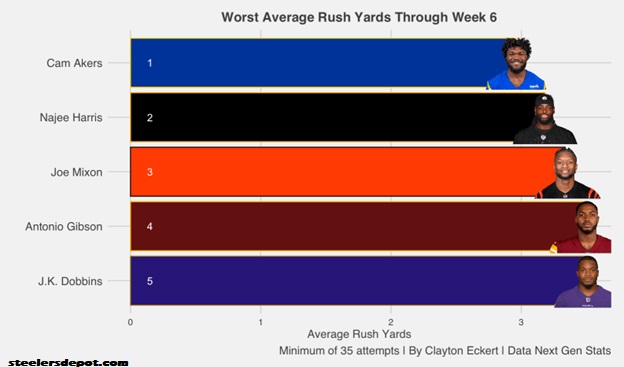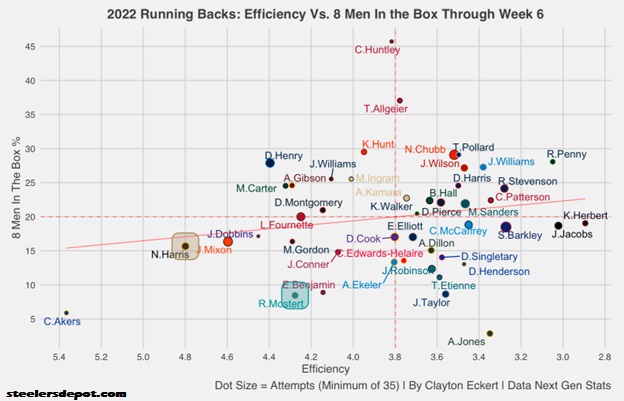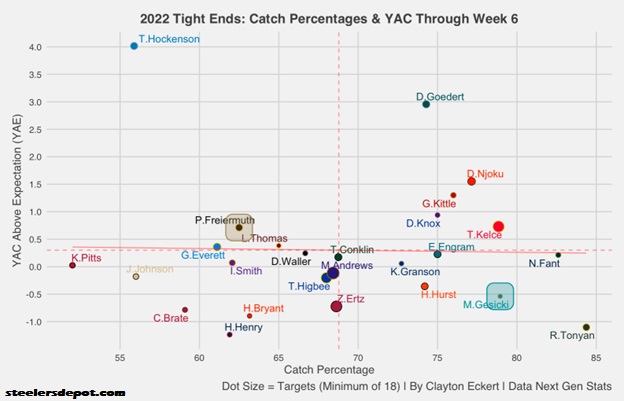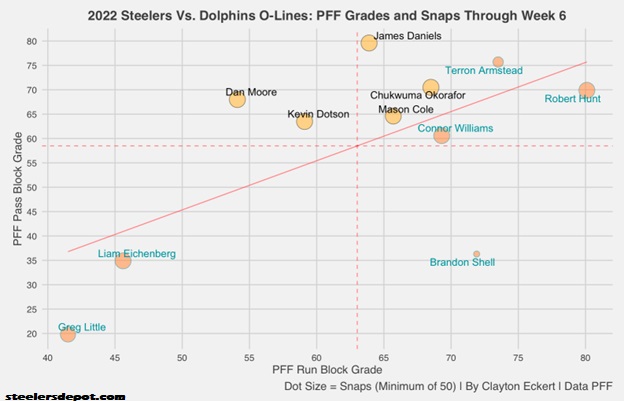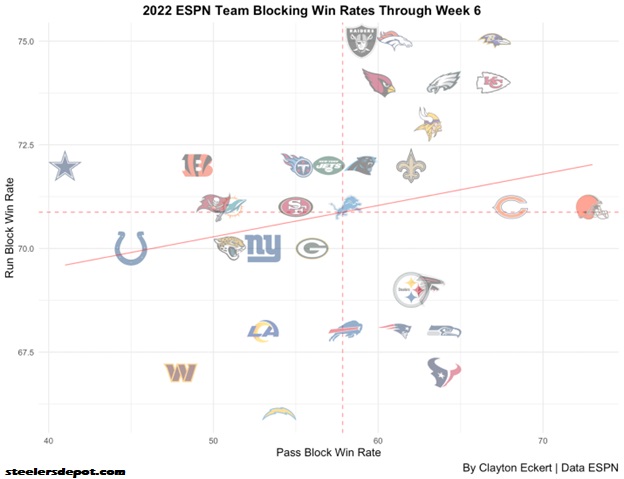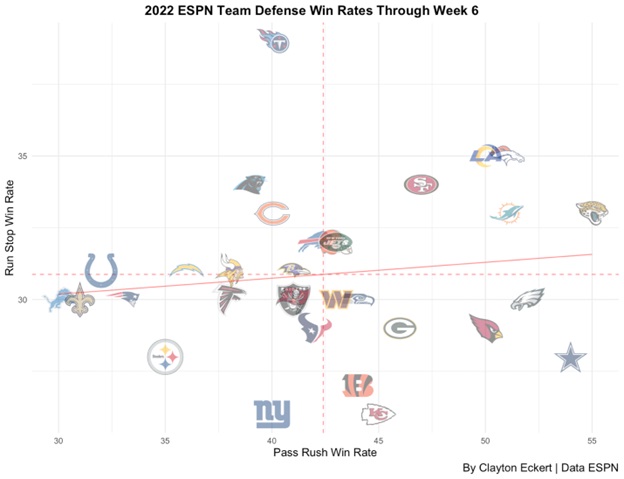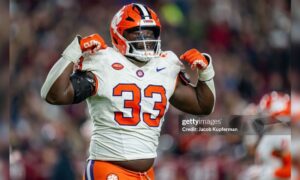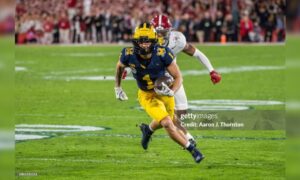The 2-4 Pittsburgh Steelers are coming off a much needed and surprising win, and face another tough challenge Sunday night against the 3-3 Miami Dolphins. They have lost three straight, but have been riding a quarterback carousel with Tua Tagovailoa, Teddy Bridgewater, and Skylar Thompson, each dealing with injuries in that span. Tagovailoa is set to make his return from his concussion, as is the case with Steelers quarterback Kenny Pickett who’s quickly available following the week six injury and practicing fully right out of the gates this week.
Let’s start with the quarterback position, with completion percentages and Next Gen Stats completion percentage above expectation metric:
Right away we can see both quarterbacks have fared well in 2022 in terms of completion rates, with Tagovailoa having the 4th rank in completion percentage (69.6%), and is also 1.4 above expectation which ranks ninth out of the 37 quarterbacks on the graph. He has 115 attempts to date (29th) for and impressive 1035 yards that is 23rd in the league (nine yards per attempt). Pickett has a 66.3% completion rate (12th) and has an even better 2.3 above expectation number that ranks sixth. He has 83 attempts (4th fewest) and has 514 yards to date, which is dead last.
Let’s add more context, looking at touchdown/interception ratios and passer ratings through week six:
The difference to date is quite blatant, with Tagovailoa playing very well in these regards, with the second-best passer rating (109.9) and an above the mean touchdown/interception ratio (eight TD’s, three INT’s). The visual also highlights the value the Dolphins have been missing when comparing to his teammates on the bottom left.
Pickett lands on the extreme lower left of the graph, tied for the worst touchdown/interception ratio (only one TD and four interceptions). He also has the second worst passer rating (67!), which is only better Thompson, ironically a Dolphins backup.
Next, let’s look at quarterbacks intended and completed air yard through week six:
Here we can see Pickett is below average in both metrics, with an intended air yards number of 7.8 that ranks 21st. His 5.5 completed air yards is the more concerning of the two, though it ranks 20th in the NFL. One way to look at this chart largely speaking is the teams/players on the bottom right are catch short and (ideally) run long, while the top right are going for it down the field. It would be huge if Pickett can increase his completed number past ten yards moving forward (11/25, 44%) for an offense that is in dire need of more splash plays as I highlighted in my recent passing locations and advanced stats articles.
Tagovailoa lands in an ideal spot in the top middle and above the mean in both data points (along with his teammate, Bridgewater), with a particularly strong 7.5 completed air yards that ranks third out of quarterbacks with at least 53 attempts. Very impressive considering his 8.6 intended air yards number that ranks lower at 15th. This is a great example of the type of quality over quantity I am hoping Pickett can find moving forward, with a higher completion rate when he does throw long for a stronger differential.
To add more context to this point, let’s see how Tagovailoa’s air yards differential (completed – intended air yards) stacks up across the NFL:
Tagovailoa lands in the top five with a -1.1 differential that ranks third, and is notably the only quarterback of this group that is above the mean in intended air yards through week six. In comparison, Pickett’s -2.3 number ranks 19th, and the worst in the league is -3.2. This highlights the deep connection and success Tagovailoa has had in 2022, particularly with wide receivers Tyreek Hill and Jaylen Waddle (questionable, but will seemingly play).
Speaking of which, let’s jump to the wide receivers and look at receiving yards leaders:
Impressively Hill and Waddle are in the top five in receiving yards, the former one of the best players in the NFL at his position and currently leading the league with 701 yards. Waddle has 533 yards through week six, and completes a dynamic duo that will be an extremely tough task for Pittsburgh. The defense will be getting reinforcements back in the secondary after being depleted last week, though they played admirably against the Bucs. Cornerback Ahkello Witherspoon is doubtful for the matchup on thankfully a much shorter injury report this week. Looking for a similar approach in scheme to last week, where the defense mixed up their coverages, largely a variety of zone concepts that were successful against Brady, and can’t wait to see if this is the case again and how they fare against this dynamic passing attack.
Next, let’s look at targets and receptions for the position:
Right away we get context to Hill’s league leading yards, one of the highest volume players to date with 65 targets (T-2nd), 50 receptions (2nd), and two touchdowns out of the 85 qualifying players. His first touchdown as a Dolphin came against the Ravens in week two, a 48-yard deep middle heave, along with another getting free on a go route for the easy 60-yard score, throwing up his patented deuces and coming up huge in their fourth quarter comeback from a two-score deficit to get the win. Hill’s longest play to date came against the Bengals in week four, another deep middle target for 64 yards. This highlights a primary concern for Pittsburgh in the game, with Miami having 25 total explosive plays on the season (T-9th), while the Steelers defense has allowed 31, which is tied for the most in the NFL. Fingers crossed this is another game that Pittsburgh can keep the lid on or we’re in for a long game.
Steelers wide receiver Diontae Johnson has the eighth most targets in the NFL (57), along with 33 receptions (T-10th) for 295 yards (32nd), and no touchdowns. Hopefully this is the week Johnson can get across the all-elusive goal line this week. In comparison, Waddle has 49 targets and 30 receptions, each tying for 16th and giving additional context to the maximization of his opportunities in yardage along with three touchdowns. He undoubtably benefits from the attention Hill gets, and this could lead to a big game considering the amount of focus Pittsburgh’s defense tends to put on primary receivers. The graph also highlights the high dosage of the two, with no other receiver on the team meeting the minimum targets to make the graph. Another element that both Hill and Waddle have provided great value in are first downs, the former tying for second in the NFL with 31 and the latter with 23 (T-7th).
Pittsburgh wide receiver Chase Claypool lands right at the mean and now has 36 targets, 23 receptions, and 241 yards and is coming off a great game where he improved in virtually every aspect of the game and caught all seven of his targets. He also provided the first wide receiver touchdown for the team (finally!), along with huge value in situational football (third down/red zone) and really hoping he can keep this positive trend going. Fellow wide receiver George Pickens has 34 targets, 20 receptions, and second at the position for Pittsburgh with 277 yards. He had a down game last week, particularly struggling to connect with Pickett, and hopefully they can get back to their prior success from weeks four and five.
Miami’s other receivers include Trent Sherfield, who has 15 targets, 10 receptions, and 88 yards. Cedrick Wilson is another quality player that currently has seven targets, four receptions, and 40 yards. River Cracraft is the least targeted player for the team at the position (6), with only two catches, but both of those went for touchdowns, each from the red zone in spread formations.
Now let’s see how the players created on their opportunities with separation, along with their catch percentages:
Hill tops yet another graph, the sixth ranked separator in the NFL at 3.75 yards, along with an insanely good catch rate considering his volume of 76.9% which ranks seventh. Hill has played 58.8% of his pass snaps out wide this season along with 36% in the slot, and while he is always a concern, lining up in the latter against Pittsburgh’s defense that could create poor matchups has me worried the most. Waddle lands near the mean in both data points with a 2.89 separation number that ranks second in the outlook and 43rd in the NFL. His 61.2 catch percentage is third in the outlook (just below Claypool) and ranks 47th league wide. Waddle has primarily played out wide (72.3%) along with 26.8% in the slot, and it will be interesting to see who gets the primary duties for each in coverage.
Claypool has a 63.9% catch rate that is second in the outlook, and leads the team in separation (2.59), though each Steeler receiver is well below the mean in this regard. Never thought I would write that sentence after tracking Claypool’s extremely low 2021 results. Claypool has played 80.8% of his pass snaps from the slot and 19.2% out wide. Pickens has the lowest separation in the outlook (2.45), which is 16th least in the league through week six and has played 90.9% out wide. Johnson’s separation numbers are surprisingly low this year, just below Claypool (2.58) along with the worst catch percentage in the outlook (57.9) and 90% of his pass snaps have come out wide. The Buffalo game was particularly poor (12 targets, five receptions) but Johnson had his highest catch rate of the season last week (71.4), though his five catches only went for 28 yards. So, the alignments have been just as predictable as the route concepts, though there was a bit more variety last week which hopefully continues.
This brings up another huge element (of many) I’m hoping will improve Sunday night for Johnson and the team as a whole, yards after catch. Here are the results along with Next Gen Stats YAC Above Expectation (YAE) metric through week six:
Waddle takes his turn atop these results, with the fifth ranks in both data points. He has a 7.9 YAC average and is three yards above expectation, which sheds light to his receiving yards results from earlier. One example was his touchdown against the Patriots in the season opener, catching the intermediate over the middle target and eluding three defenders for 30+ YAC yards on the 42-yard touchdown and big fourth down conversion before halftime. His longest gain on the year came in the aforementioned Ravens game, aligning in the slot and running a double move to get vertical and open up the seam for the intermediate target, then providing 40+ YAC yards on the gain of 59. His two other touchdowns on the season came in this contest as well, including the clutch game winner. Double explosives, over the middle, ending in the end zone, very envious watching this offense through Steelers lenses.
Hill is also above the mean in both data points, with 5.5 YAC (23rd) and a 1.1 YAE that ranks 24th. While his numbers aren’t as impressive as Waddle’s to this point in terms of YAC to date, Hill has forced nine missed tackles which ties for third most in the NFL. Pittsburgh HAS to have another strong showing in the tackling department as they did last week, highlighted very well by our own Josh Carney in his weekly missed tackles report.
Claypool also provided a solid game in terms of YAC last week, improving his YAC number to 3 and has trended positively the last three weeks. His YAE is now right at league average (0.6) which ranks 39th in the NFL. Pickens has a low 2.3 YAC number which ranks (73rd), but his 0.3 YAE is a much stronger 46th rank. Johnson still has the NFL’s worst 0.8 YAC number, and the only player under a yard, along with a -0.9 YAE that ranks 76th. Really hoping Claypool can continue his positive trend, and looking for Johnson to start dominate his matchups more, optimistically stepping up by particularly creating more with the ball in his hands considering his short targets on average aren’t going away any time soon.
Paired with the intended air yards results I highlighted for Pickett earlier, the YAC results above really highlight that one or the other (or optimistically both) need to improve. Miami’s success in this regard will definitely be a handful on Sunday night.
Next let’s look at the running backs, and here are the rushing leaders through week six:
Miami running back Raheem Mostert lands near the mean in both data points, and leads the outlook with 309 rush yards, which is 23rd in the NFL through week six. In comparison, Steelers running back Najee Harris has 264 rush yards (28th) on 83 attempts (13th), which is 12 more than Mostert, who has 71 (21st). Mostert also has 216 yards after contact to Harris’ 210, with the former forcing 14 missed tackles to the latter’s 13. Each have a touchdown to their name, with Mostert’s coming on a jet sweep from an inline alignment in the red zone against the Jets.
Harris leads the outlook with 18 targets, 15 receptions, 71 receiving yards (2.1 average), and two touchdowns including one last week on a wide-open swing pass, a good play design where the two receivers ran in routes to clear space for the waltz in score. Hope to see a bit more of the manufactured opportunities such as this, freeing up our playmakers who have struggled overall to say the least.
Dolphins running back Chase Edmunds is third in the outlook with 31 attempts for 89 yards, and most important an outlook high two rushing touchdowns. Both came against the Bills in week three, along with a flip pass touchdown vs. Cincinnati in week four, with all three of his scores coming in the red zone. Edmunds leads Miami with 15 targets, ten receptions, and an outlook high 96 receiving yards. This is a sneaky player in the matchup with everyone else Pittsburgh’s defense has to account for, and noticing a trend of depth players stepping up in the red area for Miami thus far. Mostert also has 13 targets, eight receptions, and 64 yards as a receiver.
Steelers running back Jaylen Warren now has 21 attempts for 96 yards on the year, and did not get the amount of opportunities I was hoping for last week (two attempts for two yards), given his hard and churning running particularly on display in recent weeks. He has six forced missed tackles on the ground and five as a receiver, with the latter tying for eighth in the NFL. Warren has not eclipsed five rush attempts in a game, and had a three-game stretch (weeks 3-5) where he averaged 7.5, 6, and 4.8 rush yards. The team needs to turn every stone for hopeful improvements, and last week it was turning to jet sweeps to the wide receivers. Claypool has had the most success and opportunities on the season, with eight attempts for 55 yards (6.9 average). If it were me, I would involve these two on Sunday night.
Seeing Harris’ lowest yardage of players with at least 80 attempts on the visual above, I wanted to see how his average rush yards fared across the league:
Out of the 46 players with at least 35 attempts from the previous view, Harris has the second worst average rush yards (3.18). He has also not eclipsed 75 yards in a game, with his best outing coming against the Jets in week four, when he had 74 yards on 18 attempts (4.1 average). Ouch. In comparison for the outlook, Mostert has a 4.35 average rush yards number that ranks 22nd in the league, and has three explosive runs of 20 yards or more, a pipe dream if you’re a Steelers fan that throws a parade for each successful run. Edmunds also has an explosive run, and hopefully the Steelers defense can eliminate this element of the game, and perhaps get one of their own on offense (maybe Warren?).
One last thing for the running backs, here are the efficiency numbers (total distance a player traveled on rushing plays as a ball carrier, the lower the number is more of a north/south runner) along with rates at which they have seen eight-man boxes:
Right away we can see Harris has the second worst efficiency (4.8), and really hope this is an element he can focus on improving on, getting up field more quickly as opposed to sideline-to-sideline. He has seen eight men in the box 15.66% of the time, which is 33rd in the league, so it’s not like defenses are aggressively scheming the run. Mostert is also below the mean in both data points, with a 4.28 efficiency number that ranks 38th, along with seeing eight men in the box only 8.45% of the time, which is third least. This does shed light on more ideal opportunities for Mostert in comparison to the league, and the Steelers run game struggles are due more to the offensive line struggles (more on that to come).
Miami has the third highest play action plays (62) in the NFL, along with fifth most run pass option plays (27), so hopefully this is an element that the Steelers coaches have hopefully prepared the defense for, particularly needing a quality effort in the read and react department from linebackers, with Myles Jack and Devin Bush hopefully providing another strong game. In comparison, the Steelers offense has only 22 play action plays which is tied for third least and 11 run pass options, which is tied for 18th.
Time for the tight ends, and we’ll start things off with receiving stat leaders in 2022 thus far:
Even after leaving the week five game along with missing last game due to injury, Steelers tight end Pat Freiermuth is still above the mean with 32 targets (12th) and 235 yards which ranks ninth out of the 26 players at the position. He has encouragingly practiced in full this week, and set to make his much needed return to an offense that needs all their weapons at their disposal. Dolphins tight end Mike Gesicki is below average with 19 targets, which is tied for the fewest on the graph along with 170 yards (T-16th).
I also wanted to provide catch percentages and YAC above expectation results for the position through week six:
While Gesicki’s opportunities have been limited, he has maximized them with the fourth ranked catch percentage (78.9) and ninth best separation (3.51), despite seeing the sixth least amount of cushion (5.23), along with three touchdowns which ties for third. Two of his scores came last week against the Vikings, each coming in the red zone in the fourth quarter. The first was a great route settling between two defenders to gain separation, and the latter a third and goal catch getting wide open in the back of the end zone late in the game, but it was too little too late with the team down two possessions in the loss. His most impressive touchdown came in the Ravens game, also from the red zone, getting behind the defense and making the nice leaping catch and getting both feet inbounds for the score in the third quarter. His YAC result is well below the mean (-0.5) which ranks 21st. Freiermuth has a 0.7 YAE number that ranks 7th, but a low 62.5 catch percentage (19th). Hopefully he can provide a great game in many facets, particularly building on his 4.63 yards after catch average for a team that has struggled in this regard, and hopefully an improved connection with Pickett in this game being a big key.
Now for the offensive lines, here are the PFF grades for run and pass blocking along with snap totals:
Dolphins right guard Robert Hunt has the highest grade in the outlook, with an 80.1 as a run blocker that ranks 14th in the NFL, along with a respectable 69.9 pass block grade that ranks fourth in the outlook. Two other Dolphins are above the mean in both data points for the matchup, starting with left tackle Terron Armstead (questionable, but seems he’ll play) who has the second ranks in the matchup, with a 75.7 pass block grade along with a 73.5 as a run blocker. His availability is huge given his quality of play, and considering Steelers edge rusher Alex Highsmith would have a more ideal matchup against Brandon Shell, who has filled in at both tackle spots with a respectable 71.9 run block grade but a very low 36.6 as a pass blocker that would be facing the NFL sack leader. Center Connor Williams is the final above the mean player for the team, and has fared better as a run blocker (69.3) according to PFF, and pairs this with a 60.6 as a pass blocker. Williams also ranked fourth in ESPN’s run block win rates this week, and here’s to hoping defensive lineman Cameron Heyward and company can buck this trend. Each of these starters have fared stronger than Pittsburgh as run blockers.
The remaining Miami starters have really struggled, starting with left guard Liam Eichenberg who has a 45.6 run block grade and a poor 34.9 pass block grade, with 18 pressures and two sacks allowed. Right tackle Greg Little (who is also questionable) lands on the extreme lower left, with a poor 41.5 run block grade, and a horrendous 19.8 pass block grade. Don’t think I’ve seen that low of a grade for a player with that many snaps (363), with PFF having him down for allowing a whopping 25 pressures (most in the NFL) and four sacks (T-3rd most). Really hoping Steelers edge rushers Alex Highsmith and Malik Reed can capitalize on this side, with the latter playing the vast majority of snaps on this side to date.
Pittsburgh guard James Daniels has the highest pass block grade of the outlook (79.6), which ranks 17th in the NFL through week six, continuing a negative trend after ranking fourth earlier in the season. Daniels also ranks eighth in ESPN’s pass block win rates for guards, and is the only Steeler that is not charged with a sack by PFF. Tackle Chukwuma Okorafor has the third ranked pass block grade in the outlook (70.5) but has allowed a team high 12 pressures and a sack, along with a 68.5 as a run blocker. Center Mason Cole’s run block grade is the better of the two (65.7), pairing this with a 64.6 pass block grade with eight pressures and a sack allowed. Guard Kevin Dotson had a very rough game last week, particularly as a pass blocker and now has the lowest grade on the team in this regard (63.5), along with a 59.1 as a run blocker, and is currently tied for the second most penalized offensive lineman in the NFL. Tackle Dan Moore has the third ranked pass block grade for the team (68) though he’s allowed ten pressures and two sacks, and a team low 54.1 as a run blocker.
With many questions on how Pittsburgh can potentially fix the running game, I looked into the PFF numbers for zone and gap runs. They have run 64 zone schemed runs, where each Steelers lineman has a 70+ grade except Moore. On 41 gap runs, all have below 70 grades, with Okorafor having the strongest grade (66), and the other four below 60. Not a magic wand fix, but very telling data that suggests leaning into zone schemes even more moving forward would be worth a shot for hopeful improvement. If Warren is used more moving forward, this could be a natural way to increase these opportunities, considering 14/21 of his rushes have been zone schemed.
Here are how teams have fared in ESPN blocking win rates through week six:
Pittsburgh lands on the bottom right of the graph, with an above the mean pass block win rate that encouragingly ranks tenth in the NFL, but their run blocking lands well below average, with their win rate ranking 24th. Miami’s best mark is run blocking, with the 16th rank at the NFL mean, and are 26th in pass blocking. So, ESPN and PFF tend to agree on the teams strengths and weaknesses, and let’s see how this pairs with their defensive metrics (pass rush and run stop win rates):
Right away we see Pittsburgh stands alone on the bottom left of the graph, with the 28th rank in both data points. All the injuries they have dealt with does play a big part, but expect this to trend positively with many players are returning in this matchup sans T.J. Watt. In his absence, Reed quietly has the third rank in run stop win rate. Highsmith has the league lead in sacks (6.5), 26 combined tackles, six tackles for loss, nine quarterback hits, two forced fumbles, and a pass deflection. Safety Minkah Fitzpatrick is still tied for the second most interceptions in the NFL with three, along with 33 combined tackles, four passes defensed, a defensive touchdown, and a quarterback hit. Linebacker Myles Jack leads the team with 50 combined tackles, which is 17 more than any other Steeler (Fitzpatrick’s second), along with two tackles for loss, one quarterback hit, and a huge pass deflection from last week that was a great leaping attempt to prevent a likely touchdown. Fellow linebacker Devin Bush had a crucial pass deflection last week as well, breaking up the two-point conversion that would have tied the game late. He also has 30 combined tackles and a quarterback hit to date. Cornerback Cameron Sutton leads the team with five passes defensed, along with 16 combined tackles, one for a loss, and two interceptions.
Miami is one of the best team defenses in both regards, with a particularly strong pass rush win rate that ranks fourth, along with a sixth ranked run stop win rate. Defensive lineman Christian Wilkins (questionable) is having a great season, and has the second rank in run stop win rate along with the fourth rank in pass rush win rate amongst defensive tackles. He leads the team in tackles for loss (six), has 32 combined tackles (fourth), a quarterback hit but no sacks, along with a pass deflection. Edge rusher Jaelen Phillips has the eighth rank in run stop win rate for the position. He is also tied for the team lead in fumble recoveries (two), has 13 combined tackles, five quarterback hits, two tackles for a loss, 1.5 sacks, and a pass deflection. Defensive lineman Zach Sieler has the tenth ranked run stop win rate for defensive tackles. Cornerback Xavien Howard (questionable) leads the team with five passes defensed, and has 17 combined tackles. Safety Jevon Holland has the only interception through six weeks, along with 29 combined tackles, a quarterback hit, 1.5 sacks, a forced fumble and recovery, and three passes defensed.
Former Steeler Melvin Ingram is tied for the team lead in sacks (two), and has ten combined tackles, three for a loss, three quarterback hits, a forced fumble and two fumble recoveries with one going for a touchdown, and a pass defensed. Safety Brandon Jones is tied for the team lead in sacks, ranks first on the team in combined tackles (42), two quarterback hits, a tackle for loss, a forced fumble, and three pass deflections. Defensive lineman Emmanuel Ogbah (questionable) leads the team with six quarterback hits, has ten combined tackles and one for a loss, and a sack. Linebacker Jerome Baker is tied for second in combined tackles (34), has two tackles for loss, two quarterback hits, 1.5 sacks, and two pass deflections. Fellow linebacker Elandon Roberts matches in combined tackles, has four tackles for loss, two quarterback hits, and 1.5 sacks as well. Lots of quality players and playmaking that will make life for the Pittsburgh offense difficult on Sunday night, and will be interesting to see who is unable to play for Miami on Sunday night considering their long list of questionable players.
To close, I wanted to look at and provide very important team metrics for both sides of the ball. Looking at one of the most important singular stats for team success (Adjusted Net Yards per Pass Attempt), Miami has the sixth rank on offense compared to the Steelers being dead last. From a defensive perspective, Pittsburgh has the better mark at 19th while the Dolphins defense sits at 31st. Turnover differentials (takeaways – turnovers) are always a big factor in the outcome of games, and Pittsburgh currently has the edge on the season with a +1 mark (10 takeaways, nine turnovers), compared to the Dolphins -5 (four takeaways, nine giveaways). Here’s to hoping that trend continues, considering the explosive play element that is normally paired with this, and the challenge Miami’s offense presents as I highlighted earlier. In terms of explosive plays (run or pass) allowed by the defenses, the Steelers have allowed 17, which is the fourth fewest in the NFL compared to the Dolphins at 23, which is near league average and tied for 15th. The Dolphins have blitzed at the ninth highest rate in the league, but rank 30th in pressure percentage, and in comparison Pittsburgh rank 19th in blitz percentage while ranking 29th in pressure percentage. So, both squads are lacking in the pressure department, and if Miami’s blitz rate remains high, I’m hopeful this will lead to some quality opportunities in the passing game where Pickett can hopefully find more open receivers with less men in coverage.
How do you see the game playing out on Sunday night? Thanks for reading and let me know your thoughts in the comments!


